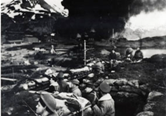-
Government
City Services-
DepartmentsCity Manager Administration City Clerk Finance Fire Department Human Resources Library Parks Culture and Recreation Planning Police Department Ports and Harbors Public Utilities Public Works
-
Mayor & City CouncilMayor & Council Agendas and Minutes Meeting Schedule Public Comment at Meetings Ordinances Resolutions Trip Reports City Code Annual Budget Lobbyist Reports Staff Directory
-
Committees & CommissionsHistoric Preservation Commission Library Advisory Committee Parks, Culture & Recreation Committee Planning Commission Apply to ServeElection InformationRegistering to Vote Polling Location Absentee Voting FAQ

Did You Know?
Did you know that the waters around Unalaska Island are one of the few places in the world to find the rare Whiskered Auklet?
-
-
Commerce
Port/Business-
PortPort Department Dock Facilities and Services AirportFisheriesCommercial Fishing Seasons Sport Fishing Seasons Fisheries Links Fisheries Reports Fish Species common in Alaska
-
BusinessBids and RFPs Business Directory Business Licensing Community Profile Economy Forms and Permits Shipping & Cargo Taxes Unalaska Visitors Bureau
-
TaxesPersonal Property Taxes Real Property Taxes Sales Taxes

Did You Know?
Did you know that Unalaska/Dutch Harbor was bombed by the Japanese during WWII?
-
-
Community
Residents/Visitors-
About UnalaskaCommunity Profile Economy Frequently Asked Questions History Is it Unalaska or Dutch Harbor? Passenger Transportation Photo Galleries Plants Population Shipping and Cargo Weather Wildlife WWII in the Aleutians
-
VisitorsVisitor Bureau Library Museum of the Aleutians Parks & Trails Passenger Transportation Sport Fishing Seasons Things To See & Do Tour Operators WWII National Historic Area and Visitor Center
-
ResidentsAnnual Festivals and Events Community Calendar Emergency Preparedness Health Care Library Non Profits & Community Services Parks & Trails Recreation Schools Sport Fishing Seasons

Did You Know?
Did you know that Unalaska is 800 miles from Anchorage and farther West than Hawaii?
-
-
I want to...
Help Center-
ApplyJob Board/Commission Building Permit Burn Permit Business License Fireworks Permit Pet LicenseContactStaff DirectoryRequestPublic Records Public Safety Records Utility Service
-
PaymentsUtilities TaxesRegisterVoter Registration Vehicle RegistrationReportBuilding Code Violation Road Maintenance Issue Street Light Outage Animal Control Issues
-
ViewAgendas and Minutes Annual Budget Bids & RFPs Code of Ordinances Calendar of Meetings Community Events Documents, Reports, & Presentations Forms, Permits & Applications Property Parcel Info Schedule of Fees & Charges Mapping & GIS

Did You Know?
That Unalaska’s Port of Dutch Harbor is the #1 Commercial Fishing Port in the United States, based on quantity of the catch and has been for more than 25 years?
Find Out More-
Energy Efficiency Tips
There are several benefits to using less electricity, including environmental benefits and decreasing your electrical bill. Try these tips:
-
Refrigerators use a large percentage of a household's electricity use. Set your refrigerator to cool to somewhere between 38-42 degrees, and your freezer 0-5 degrees. If you've got an energy saver switch, make sure it's on. Doors should be sealed tight: to test, stick a dollar bill between the gaskets and close the fridge door; if the bill is hard to pull out you're in good shape. If not, it's time to replace the gaskets.
-
Wash only full loads in your dishwasher and activate the air dry function.
-
Do your laundry with cold water whenever possible. Heating hot water accounts for 90% of the energy used by your machine (only 10% is used by the motor).
-
Lower the temperature of your hot water heater to 120-130 degrees (any lower than that might backfire on you, since you might end up running out of hot water).
-
Dirt and neglect are the top causes of heating and cooling system inefficiency and failure. Change your system's air filter regularly and have routine maintenance performed by a qualified technician.
-
Set your computer to revert to the sleep mode when not in use. Windows users can do this via the control panel, while Mac users can find energy saving settings under system preferences in the apple menu.
-
Replace standard light bulbs with compact fluorescent light bulbs, and don't forget the porch light and bathroom vanity, which are two of the most used lights in your home.
-
Turn off lights when not in use.
-
Unplug electronics, battery chargers, and power adapters when not in use. Many of these items continue to use electricity when not in use.
-
Make sure all heating vents are clear of furniture and rugs in order to improve airflow and comfort.
-
Use the right sized pots with stove burners; for example, a 6" pot on an 8" burner wastes over 40% of the heat generated. Cover pots and pans when cooking to keep heat in.
- If you replace home appliances, purchase energy efficient models. Appliances manufactured before 1993 use twice as much energy, on average, to new energy efficient appliances.
For more in depth information, review the pamphlets provided in the document center.
